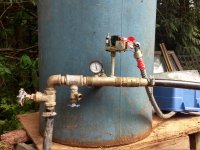APK
New Member
I apologize if this information i already available. I made a cursory attempt to find it but wasn't successful.
I am replacing my well pressure tank as per advice of a professional driller/well guy. He says I'm probably on borrowed time with my pump too but suggested I just borrow it as long as I can. He also recommended that, if I felt comfortable, I would save money by doing it myself. I'm taking him up on it. He gave some advice but of course, now that I'm actually about to do it, I have questions.
First. I don't know when lead laws came into play and am considering replacing all the hardware at the tank, along with the pressure switch when I install the new one (an 86 gallon Amtrol Well X-Trol) since it seems like these may be old enough to have high lead content.
Unless I completely misunderstood what he said, the well guy told me that the line coming up from the ground on the left in the photo is coming from the well (which is about 60 feet from the tank). Is there a way to confirm this? In all the photos and youtubes I've looked at, the hose bibs are on the house side and the pressure switch and check valves are on the side of the line coming from the well.
The guy also recommended I get a 7 gpm Dole valve. He said that I should put it in line on the poly pipe on the right side of the photo which, if that is the line to the house, I guess means, the arrow should be pointing to the right?
I think that is everything at the moment. I wish I had just coughed up the money since I've spent way more time on this than the equivalent in dollars.
Thanks in advance for any help. I can post the image full size if it makes a difference.

I am replacing my well pressure tank as per advice of a professional driller/well guy. He says I'm probably on borrowed time with my pump too but suggested I just borrow it as long as I can. He also recommended that, if I felt comfortable, I would save money by doing it myself. I'm taking him up on it. He gave some advice but of course, now that I'm actually about to do it, I have questions.
First. I don't know when lead laws came into play and am considering replacing all the hardware at the tank, along with the pressure switch when I install the new one (an 86 gallon Amtrol Well X-Trol) since it seems like these may be old enough to have high lead content.
Unless I completely misunderstood what he said, the well guy told me that the line coming up from the ground on the left in the photo is coming from the well (which is about 60 feet from the tank). Is there a way to confirm this? In all the photos and youtubes I've looked at, the hose bibs are on the house side and the pressure switch and check valves are on the side of the line coming from the well.
The guy also recommended I get a 7 gpm Dole valve. He said that I should put it in line on the poly pipe on the right side of the photo which, if that is the line to the house, I guess means, the arrow should be pointing to the right?
I think that is everything at the moment. I wish I had just coughed up the money since I've spent way more time on this than the equivalent in dollars.
Thanks in advance for any help. I can post the image full size if it makes a difference.


